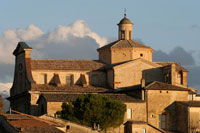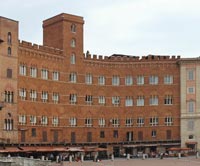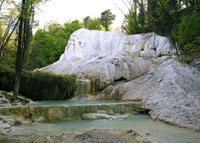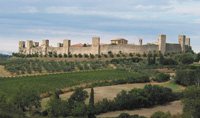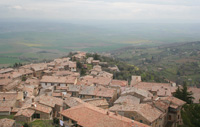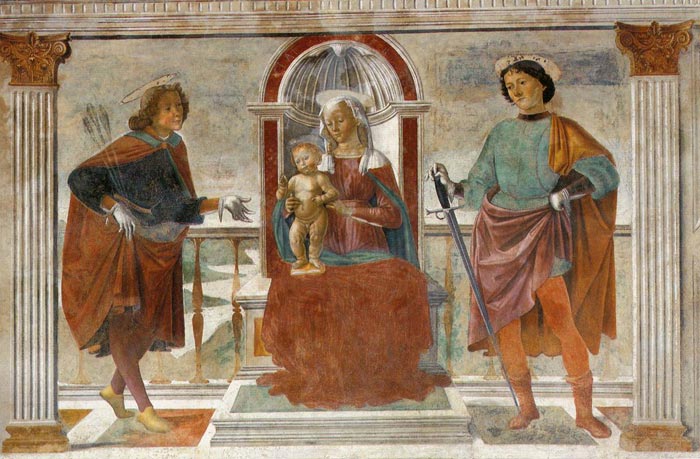 |
| Domenico Ghirlandaio, Madonna and Child with St Sebastian and St Julian, c. 1473, fresco in Sant'Andrea a Brozzi, San Donnino |
Domenico Ghirlandaio | Frescoes in Sant'Andrea a Brozzi, San Donnino, near Florence
|
| About 1473, Domenico Ghirlandaio painted the fresco Madonna and Child with Saints Sebastian and Julian in the church of Sant'Andrea a Brozzi in San Donnino near Florence. It is still disputed whether Ghirlandaio carried out this work, which is in a regrettably poor state of preservation, before or after his work in San Gimignano in about 1475. It is clear that in this Madonna and Child he does not appear to have found his own style yet. When compared to Ghirlandaio's later versions of this theme, the composition appears to have been constructed rather summarily. The figures seem simply to have been lined up, as if placed on pedestals in niches, a feature that brings to mind the apse fresco in Cercina. In Sant'Andrea a Brozzi, however, the architecture - with the exception of the seashell-shaped niche above the throne and the framing pilasters - has been minimized in favour of a landscape. The saints are no longer standing in niches, but posing on a terrace high above a river. The strictly arranged figures do not overlap in any way and are standing in front of a poorly developed space. In his later use of such themes, Ghirlandaio would attempt to fill every empty space in the picture. The type of Madonna depicted and the form of the standing Christ Child are clearly influenced by Verrocchio, and it is likely that Ghirlandaio spent some time working in his workshop. The high forehead, sharp chin and narrow lips of Mary, and the upright contrapposto pose of her sturdy child are the features most clearly reminiscent of figures by Verrocchio. The Christ Child, shown naked, is seen from a frontal view standing on a small cushion lying on his mother's right thigh. This motif also was borrowed from Verrocchio and is used by Ghirlandaio on a further occasion in about 1479, on the altarpiece in Lucca, where he makes only slight changes to the child's stance. In both works, the figure of Mary with the high waistline belongs to the same type. Her garment, which has been totally destroyed above the knees in the fresco, can be reconstructed using the one shown in the later panel painting. Because of the fresco's poor state of preservation, there is little that can be said about the effect of the colours and modelling of the garments. The artistic qualities of this work have been largely destroyed, though this is not a reason for dismissing the fresco too readily. The two saints on either side of the throne are wearing fashionable clothing and posing rather affectedly. Both figures are derived from models in Castagno's Assumption of the Virgin dating from about 1450 and now in the Berlin Gemäldegalerie. This type of young man will frequently appear in Ghirlandaio's later works. Saint Sebastian on the left is turning to the Christ Child with an affectedly elegant gesture, and Saint Julian is holding out his sword. As he does so, he casually places his left hand on his hip. The same posture is rather amusing when seen in the Lucca Christ Child, as it is so unusual for a small child. The relationship of the motifs in the panel painting in Lucca and the fresco in Sant'Andrea can also be seen in the posture of the gray figure of Saint Paul, who is holding his sword in the same manner as Saint Julian. The Saint Sebastian in the panel painting has a similarly angelic face to the one in the fresco. In addition, both figures are holding arrows, the symbols of their martyrdom, with their fingertips. |
|
||
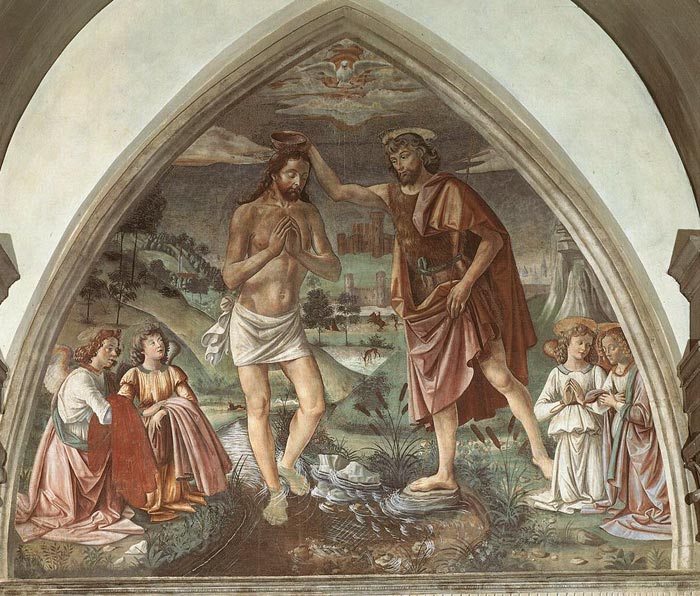 |
||
Domenico Ghirlandaio, Baptism of Christ, c. 1473, fresco in Sant'Andrea a Brozzi, San Donnino
|
||
Giorgio Vasari's Lives of the Artists | Domenico Ghirlandaio, painter of Florence
|
||
| This page uses material from the Wikipedia article Domenico Ghirlandaio, published under the GNU Free Documentation License. Wikimedia Commons has media related to Domenico Ghirlandaio and the Brozzi frescos by Ghirlandaio. |
||
Holiday accomodation in Tuscany | Podere Santa Pia | Artist and writer's residency
|
||||
Podere Santa Pia |
Podere Santa Pia, garden view, April |
Montefalco |
||
Siena, Palazzo Sansedoni |
Bagni San Filippo |
Siena, duomo |
||
Monteriggioni |
Arcidosso |
Montalcino | ||
|
||||



